University HRM Report: Employee Indication, Retention, and Turnover
VerifiedAdded on 2022/08/20
|7
|1556
|12
Report
AI Summary
This report delves into the critical aspects of employee indication, retention, and turnover within organizations. It begins by highlighting the role of Human Resources Management Systems (HRMS) in ensuring employee satisfaction and preventing business discrepancies. The report then explores various HR metrics and data sources used to predict employee retention and turnover, including revenue per employee, offer acceptance rates, training efficiency, turnover rates, and absenteeism. It discusses the application of Maslow's hierarchy of needs, equity theory, and the theory of compliance in improving employee retention. The report provides examples of successful employee retention programs at companies like Microsoft and Dell, while also acknowledging the challenges HRMS face, such as compliance and adaptability to innovation. The conclusion emphasizes the importance of effective HR metrics analysis and strategies in achieving organizational goals through high employee satisfaction and retention.
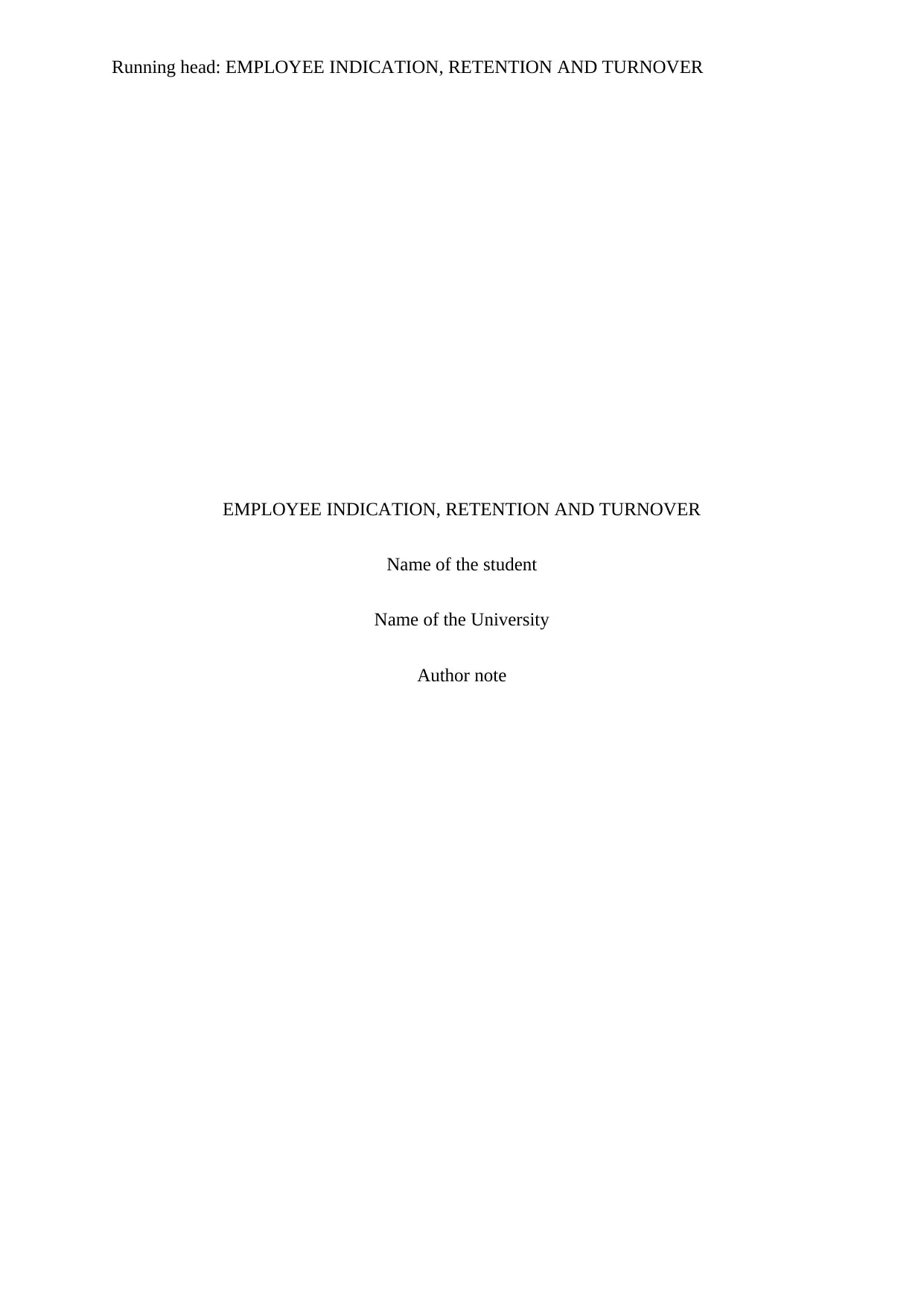
Running head: EMPLOYEE INDICATION, RETENTION AND TURNOVER
EMPLOYEE INDICATION, RETENTION AND TURNOVER
Name of the student
Name of the University
Author note
EMPLOYEE INDICATION, RETENTION AND TURNOVER
Name of the student
Name of the University
Author note
Paraphrase This Document
Need a fresh take? Get an instant paraphrase of this document with our AI Paraphraser
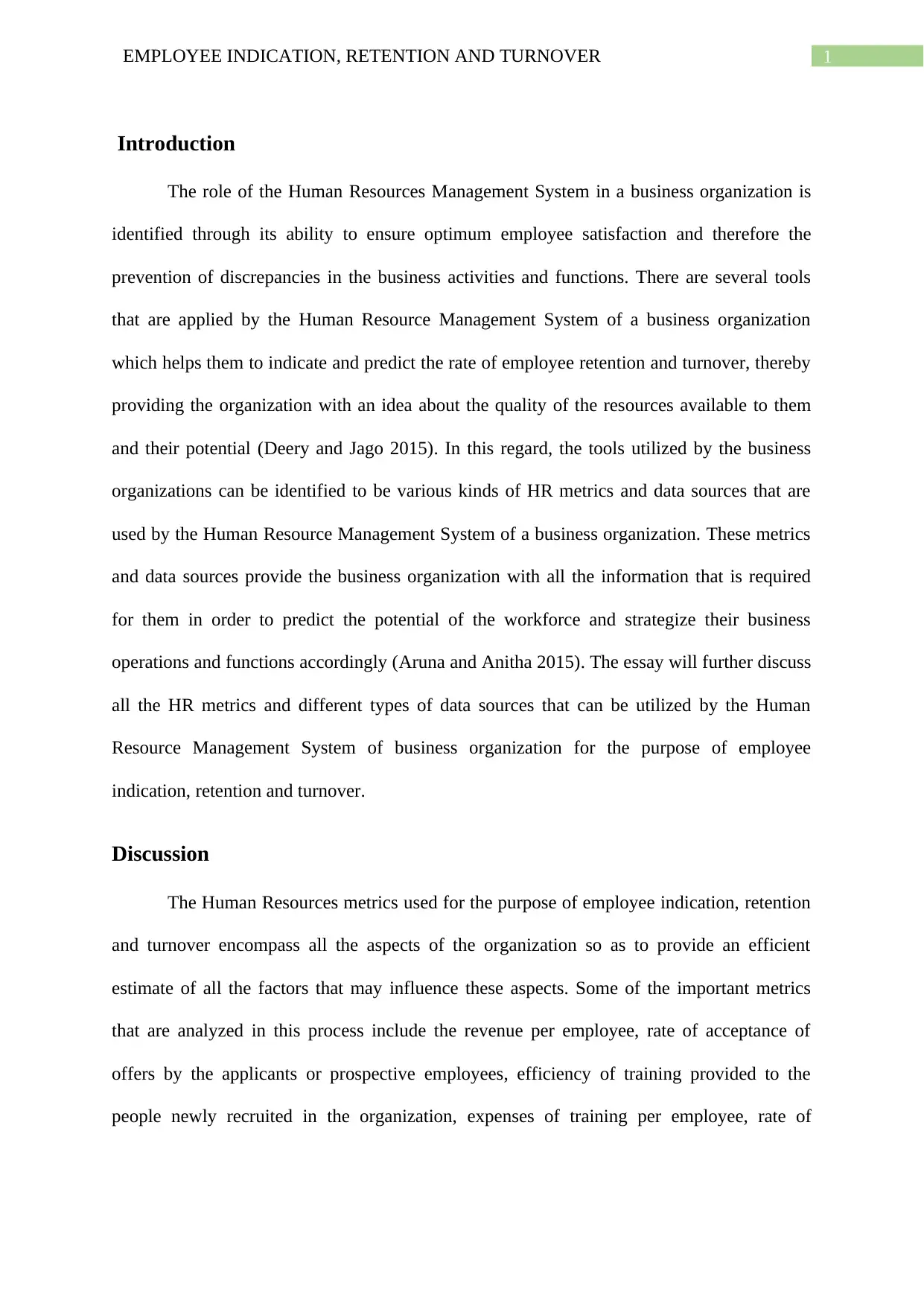
1EMPLOYEE INDICATION, RETENTION AND TURNOVER
Introduction
The role of the Human Resources Management System in a business organization is
identified through its ability to ensure optimum employee satisfaction and therefore the
prevention of discrepancies in the business activities and functions. There are several tools
that are applied by the Human Resource Management System of a business organization
which helps them to indicate and predict the rate of employee retention and turnover, thereby
providing the organization with an idea about the quality of the resources available to them
and their potential (Deery and Jago 2015). In this regard, the tools utilized by the business
organizations can be identified to be various kinds of HR metrics and data sources that are
used by the Human Resource Management System of a business organization. These metrics
and data sources provide the business organization with all the information that is required
for them in order to predict the potential of the workforce and strategize their business
operations and functions accordingly (Aruna and Anitha 2015). The essay will further discuss
all the HR metrics and different types of data sources that can be utilized by the Human
Resource Management System of business organization for the purpose of employee
indication, retention and turnover.
Discussion
The Human Resources metrics used for the purpose of employee indication, retention
and turnover encompass all the aspects of the organization so as to provide an efficient
estimate of all the factors that may influence these aspects. Some of the important metrics
that are analyzed in this process include the revenue per employee, rate of acceptance of
offers by the applicants or prospective employees, efficiency of training provided to the
people newly recruited in the organization, expenses of training per employee, rate of
Introduction
The role of the Human Resources Management System in a business organization is
identified through its ability to ensure optimum employee satisfaction and therefore the
prevention of discrepancies in the business activities and functions. There are several tools
that are applied by the Human Resource Management System of a business organization
which helps them to indicate and predict the rate of employee retention and turnover, thereby
providing the organization with an idea about the quality of the resources available to them
and their potential (Deery and Jago 2015). In this regard, the tools utilized by the business
organizations can be identified to be various kinds of HR metrics and data sources that are
used by the Human Resource Management System of a business organization. These metrics
and data sources provide the business organization with all the information that is required
for them in order to predict the potential of the workforce and strategize their business
operations and functions accordingly (Aruna and Anitha 2015). The essay will further discuss
all the HR metrics and different types of data sources that can be utilized by the Human
Resource Management System of business organization for the purpose of employee
indication, retention and turnover.
Discussion
The Human Resources metrics used for the purpose of employee indication, retention
and turnover encompass all the aspects of the organization so as to provide an efficient
estimate of all the factors that may influence these aspects. Some of the important metrics
that are analyzed in this process include the revenue per employee, rate of acceptance of
offers by the applicants or prospective employees, efficiency of training provided to the
people newly recruited in the organization, expenses of training per employee, rate of
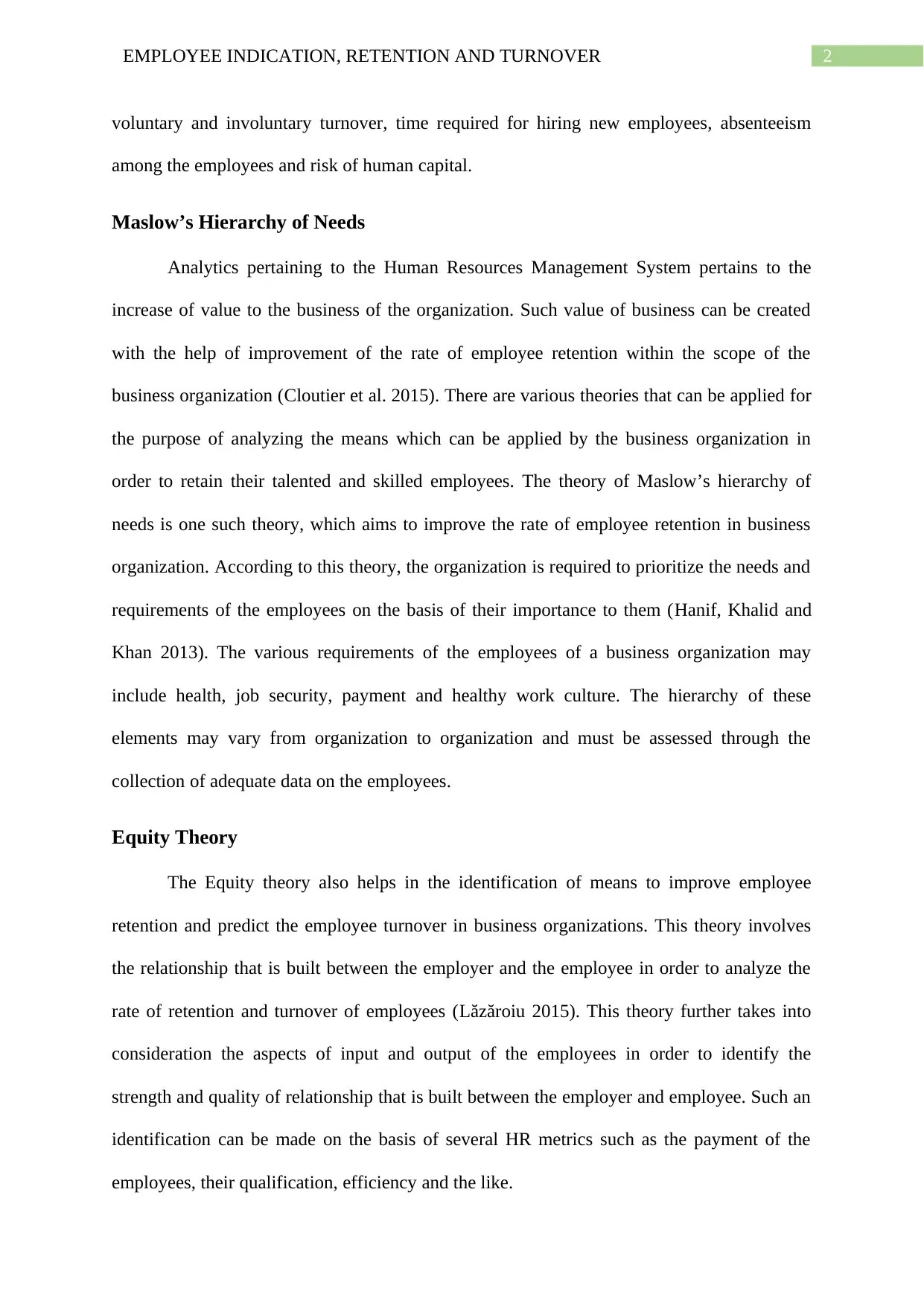
2EMPLOYEE INDICATION, RETENTION AND TURNOVER
voluntary and involuntary turnover, time required for hiring new employees, absenteeism
among the employees and risk of human capital.
Maslow’s Hierarchy of Needs
Analytics pertaining to the Human Resources Management System pertains to the
increase of value to the business of the organization. Such value of business can be created
with the help of improvement of the rate of employee retention within the scope of the
business organization (Cloutier et al. 2015). There are various theories that can be applied for
the purpose of analyzing the means which can be applied by the business organization in
order to retain their talented and skilled employees. The theory of Maslow’s hierarchy of
needs is one such theory, which aims to improve the rate of employee retention in business
organization. According to this theory, the organization is required to prioritize the needs and
requirements of the employees on the basis of their importance to them (Hanif, Khalid and
Khan 2013). The various requirements of the employees of a business organization may
include health, job security, payment and healthy work culture. The hierarchy of these
elements may vary from organization to organization and must be assessed through the
collection of adequate data on the employees.
Equity Theory
The Equity theory also helps in the identification of means to improve employee
retention and predict the employee turnover in business organizations. This theory involves
the relationship that is built between the employer and the employee in order to analyze the
rate of retention and turnover of employees (Lăzăroiu 2015). This theory further takes into
consideration the aspects of input and output of the employees in order to identify the
strength and quality of relationship that is built between the employer and employee. Such an
identification can be made on the basis of several HR metrics such as the payment of the
employees, their qualification, efficiency and the like.
voluntary and involuntary turnover, time required for hiring new employees, absenteeism
among the employees and risk of human capital.
Maslow’s Hierarchy of Needs
Analytics pertaining to the Human Resources Management System pertains to the
increase of value to the business of the organization. Such value of business can be created
with the help of improvement of the rate of employee retention within the scope of the
business organization (Cloutier et al. 2015). There are various theories that can be applied for
the purpose of analyzing the means which can be applied by the business organization in
order to retain their talented and skilled employees. The theory of Maslow’s hierarchy of
needs is one such theory, which aims to improve the rate of employee retention in business
organization. According to this theory, the organization is required to prioritize the needs and
requirements of the employees on the basis of their importance to them (Hanif, Khalid and
Khan 2013). The various requirements of the employees of a business organization may
include health, job security, payment and healthy work culture. The hierarchy of these
elements may vary from organization to organization and must be assessed through the
collection of adequate data on the employees.
Equity Theory
The Equity theory also helps in the identification of means to improve employee
retention and predict the employee turnover in business organizations. This theory involves
the relationship that is built between the employer and the employee in order to analyze the
rate of retention and turnover of employees (Lăzăroiu 2015). This theory further takes into
consideration the aspects of input and output of the employees in order to identify the
strength and quality of relationship that is built between the employer and employee. Such an
identification can be made on the basis of several HR metrics such as the payment of the
employees, their qualification, efficiency and the like.
⊘ This is a preview!⊘
Do you want full access?
Subscribe today to unlock all pages.

Trusted by 1+ million students worldwide
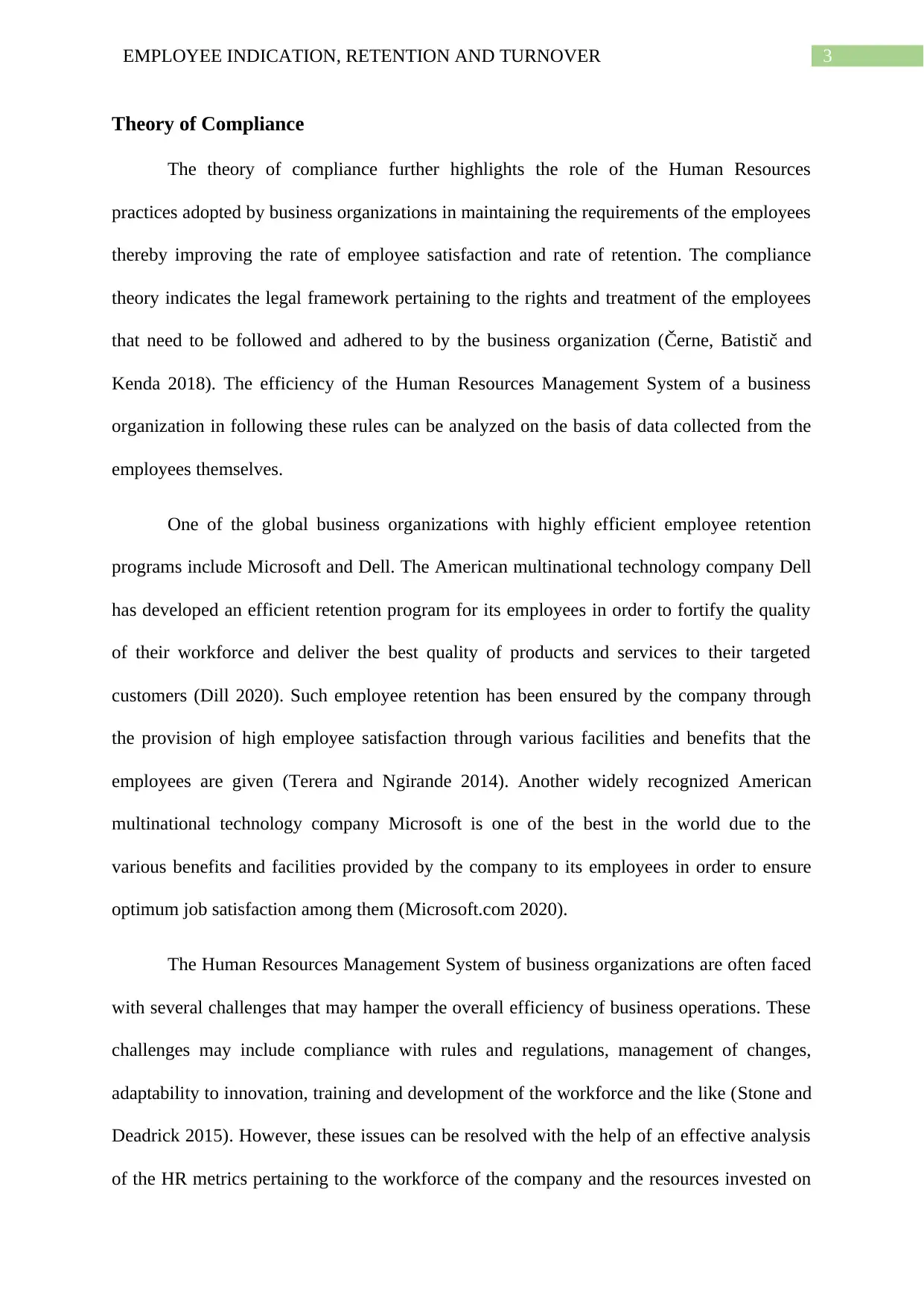
3EMPLOYEE INDICATION, RETENTION AND TURNOVER
Theory of Compliance
The theory of compliance further highlights the role of the Human Resources
practices adopted by business organizations in maintaining the requirements of the employees
thereby improving the rate of employee satisfaction and rate of retention. The compliance
theory indicates the legal framework pertaining to the rights and treatment of the employees
that need to be followed and adhered to by the business organization (Černe, Batistič and
Kenda 2018). The efficiency of the Human Resources Management System of a business
organization in following these rules can be analyzed on the basis of data collected from the
employees themselves.
One of the global business organizations with highly efficient employee retention
programs include Microsoft and Dell. The American multinational technology company Dell
has developed an efficient retention program for its employees in order to fortify the quality
of their workforce and deliver the best quality of products and services to their targeted
customers (Dill 2020). Such employee retention has been ensured by the company through
the provision of high employee satisfaction through various facilities and benefits that the
employees are given (Terera and Ngirande 2014). Another widely recognized American
multinational technology company Microsoft is one of the best in the world due to the
various benefits and facilities provided by the company to its employees in order to ensure
optimum job satisfaction among them (Microsoft.com 2020).
The Human Resources Management System of business organizations are often faced
with several challenges that may hamper the overall efficiency of business operations. These
challenges may include compliance with rules and regulations, management of changes,
adaptability to innovation, training and development of the workforce and the like (Stone and
Deadrick 2015). However, these issues can be resolved with the help of an effective analysis
of the HR metrics pertaining to the workforce of the company and the resources invested on
Theory of Compliance
The theory of compliance further highlights the role of the Human Resources
practices adopted by business organizations in maintaining the requirements of the employees
thereby improving the rate of employee satisfaction and rate of retention. The compliance
theory indicates the legal framework pertaining to the rights and treatment of the employees
that need to be followed and adhered to by the business organization (Černe, Batistič and
Kenda 2018). The efficiency of the Human Resources Management System of a business
organization in following these rules can be analyzed on the basis of data collected from the
employees themselves.
One of the global business organizations with highly efficient employee retention
programs include Microsoft and Dell. The American multinational technology company Dell
has developed an efficient retention program for its employees in order to fortify the quality
of their workforce and deliver the best quality of products and services to their targeted
customers (Dill 2020). Such employee retention has been ensured by the company through
the provision of high employee satisfaction through various facilities and benefits that the
employees are given (Terera and Ngirande 2014). Another widely recognized American
multinational technology company Microsoft is one of the best in the world due to the
various benefits and facilities provided by the company to its employees in order to ensure
optimum job satisfaction among them (Microsoft.com 2020).
The Human Resources Management System of business organizations are often faced
with several challenges that may hamper the overall efficiency of business operations. These
challenges may include compliance with rules and regulations, management of changes,
adaptability to innovation, training and development of the workforce and the like (Stone and
Deadrick 2015). However, these issues can be resolved with the help of an effective analysis
of the HR metrics pertaining to the workforce of the company and the resources invested on
Paraphrase This Document
Need a fresh take? Get an instant paraphrase of this document with our AI Paraphraser
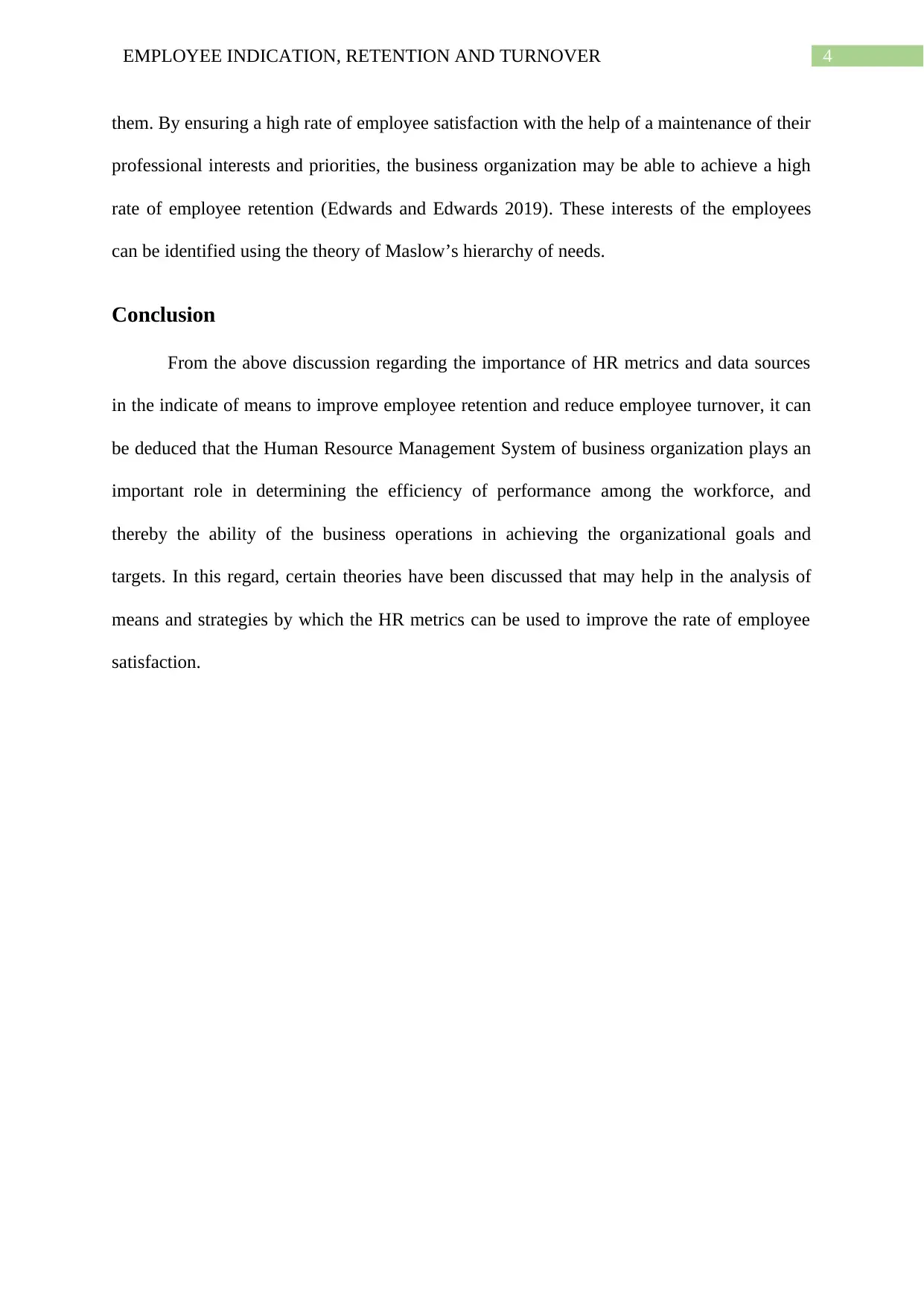
4EMPLOYEE INDICATION, RETENTION AND TURNOVER
them. By ensuring a high rate of employee satisfaction with the help of a maintenance of their
professional interests and priorities, the business organization may be able to achieve a high
rate of employee retention (Edwards and Edwards 2019). These interests of the employees
can be identified using the theory of Maslow’s hierarchy of needs.
Conclusion
From the above discussion regarding the importance of HR metrics and data sources
in the indicate of means to improve employee retention and reduce employee turnover, it can
be deduced that the Human Resource Management System of business organization plays an
important role in determining the efficiency of performance among the workforce, and
thereby the ability of the business operations in achieving the organizational goals and
targets. In this regard, certain theories have been discussed that may help in the analysis of
means and strategies by which the HR metrics can be used to improve the rate of employee
satisfaction.
them. By ensuring a high rate of employee satisfaction with the help of a maintenance of their
professional interests and priorities, the business organization may be able to achieve a high
rate of employee retention (Edwards and Edwards 2019). These interests of the employees
can be identified using the theory of Maslow’s hierarchy of needs.
Conclusion
From the above discussion regarding the importance of HR metrics and data sources
in the indicate of means to improve employee retention and reduce employee turnover, it can
be deduced that the Human Resource Management System of business organization plays an
important role in determining the efficiency of performance among the workforce, and
thereby the ability of the business operations in achieving the organizational goals and
targets. In this regard, certain theories have been discussed that may help in the analysis of
means and strategies by which the HR metrics can be used to improve the rate of employee
satisfaction.
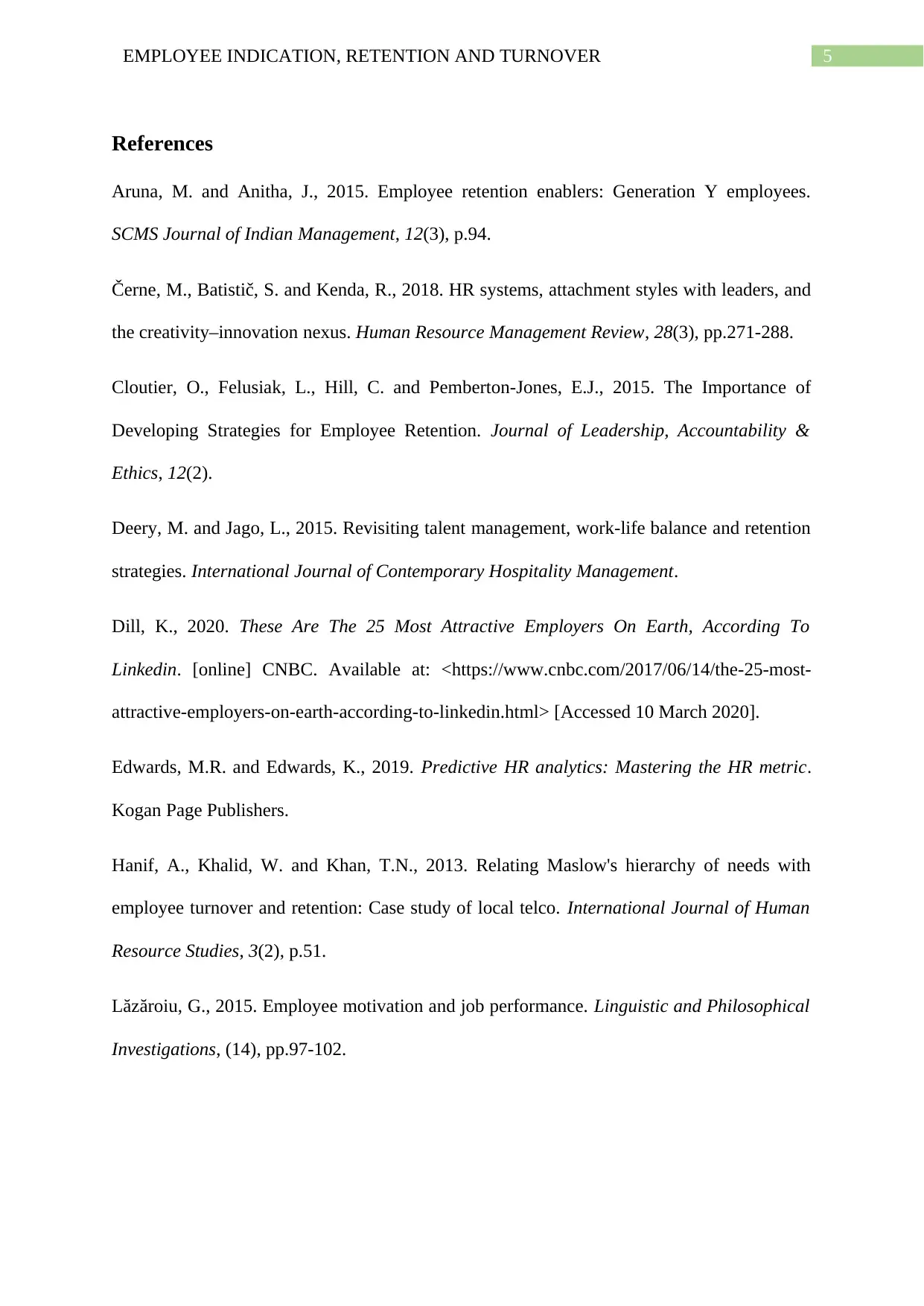
5EMPLOYEE INDICATION, RETENTION AND TURNOVER
References
Aruna, M. and Anitha, J., 2015. Employee retention enablers: Generation Y employees.
SCMS Journal of Indian Management, 12(3), p.94.
Černe, M., Batistič, S. and Kenda, R., 2018. HR systems, attachment styles with leaders, and
the creativity–innovation nexus. Human Resource Management Review, 28(3), pp.271-288.
Cloutier, O., Felusiak, L., Hill, C. and Pemberton-Jones, E.J., 2015. The Importance of
Developing Strategies for Employee Retention. Journal of Leadership, Accountability &
Ethics, 12(2).
Deery, M. and Jago, L., 2015. Revisiting talent management, work-life balance and retention
strategies. International Journal of Contemporary Hospitality Management.
Dill, K., 2020. These Are The 25 Most Attractive Employers On Earth, According To
Linkedin. [online] CNBC. Available at: <https://www.cnbc.com/2017/06/14/the-25-most-
attractive-employers-on-earth-according-to-linkedin.html> [Accessed 10 March 2020].
Edwards, M.R. and Edwards, K., 2019. Predictive HR analytics: Mastering the HR metric.
Kogan Page Publishers.
Hanif, A., Khalid, W. and Khan, T.N., 2013. Relating Maslow's hierarchy of needs with
employee turnover and retention: Case study of local telco. International Journal of Human
Resource Studies, 3(2), p.51.
Lăzăroiu, G., 2015. Employee motivation and job performance. Linguistic and Philosophical
Investigations, (14), pp.97-102.
References
Aruna, M. and Anitha, J., 2015. Employee retention enablers: Generation Y employees.
SCMS Journal of Indian Management, 12(3), p.94.
Černe, M., Batistič, S. and Kenda, R., 2018. HR systems, attachment styles with leaders, and
the creativity–innovation nexus. Human Resource Management Review, 28(3), pp.271-288.
Cloutier, O., Felusiak, L., Hill, C. and Pemberton-Jones, E.J., 2015. The Importance of
Developing Strategies for Employee Retention. Journal of Leadership, Accountability &
Ethics, 12(2).
Deery, M. and Jago, L., 2015. Revisiting talent management, work-life balance and retention
strategies. International Journal of Contemporary Hospitality Management.
Dill, K., 2020. These Are The 25 Most Attractive Employers On Earth, According To
Linkedin. [online] CNBC. Available at: <https://www.cnbc.com/2017/06/14/the-25-most-
attractive-employers-on-earth-according-to-linkedin.html> [Accessed 10 March 2020].
Edwards, M.R. and Edwards, K., 2019. Predictive HR analytics: Mastering the HR metric.
Kogan Page Publishers.
Hanif, A., Khalid, W. and Khan, T.N., 2013. Relating Maslow's hierarchy of needs with
employee turnover and retention: Case study of local telco. International Journal of Human
Resource Studies, 3(2), p.51.
Lăzăroiu, G., 2015. Employee motivation and job performance. Linguistic and Philosophical
Investigations, (14), pp.97-102.
⊘ This is a preview!⊘
Do you want full access?
Subscribe today to unlock all pages.

Trusted by 1+ million students worldwide

6EMPLOYEE INDICATION, RETENTION AND TURNOVER
Microsoft.com, 2020. Empowering Our Employees – Microsoft CSR. [online] Microsoft.
Available at: <https://www.microsoft.com/en-us/corporate-responsibility/empowering-
employees> [Accessed 10 March 2020].
Stone, D.L. and Deadrick, D.L., 2015. Challenges and opportunities affecting the future of
human resource management. Human Resource Management Review, 25(2), pp.139-145.
Terera, S.R. and Ngirande, H., 2014. The impact of rewards on job satisfaction and employee
retention. Mediterranean Journal of Social Sciences, 5(1), p.481.
Microsoft.com, 2020. Empowering Our Employees – Microsoft CSR. [online] Microsoft.
Available at: <https://www.microsoft.com/en-us/corporate-responsibility/empowering-
employees> [Accessed 10 March 2020].
Stone, D.L. and Deadrick, D.L., 2015. Challenges and opportunities affecting the future of
human resource management. Human Resource Management Review, 25(2), pp.139-145.
Terera, S.R. and Ngirande, H., 2014. The impact of rewards on job satisfaction and employee
retention. Mediterranean Journal of Social Sciences, 5(1), p.481.
1 out of 7
Related Documents
Your All-in-One AI-Powered Toolkit for Academic Success.
+13062052269
info@desklib.com
Available 24*7 on WhatsApp / Email
![[object Object]](/_next/static/media/star-bottom.7253800d.svg)
Unlock your academic potential
Copyright © 2020–2025 A2Z Services. All Rights Reserved. Developed and managed by ZUCOL.





